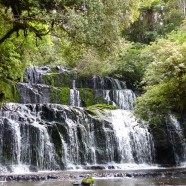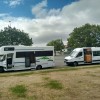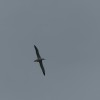
Last night it rained and right now in the early morning it is wet and cold outside and the promised view of the mountains is hidden by large clouds. But a faint sun is already trying hard to break through the clouds and in a few hours it will be sunny and the temperatures will be nice enough to walk around in a T-shirt. Welcome to camping in New Zealand.
We are now on the road for one week and we have our first rest day, no planned activities and no driving around with the camper. Time for the kids to play and time for us to do the laundry and and to update the blog. Because there are so many nice things to do and distances in New Zealand are fast, it is so easy to fill every hour of every day with activities and that is exactly what we have been doing for the past week.
When the grandparents arrived we stayed for two nights in Christchurg to get them used to the time difference. Then about a week ago we picked-up our campervans in Christchurg. Or at least that was the plan. But when we arrived at the camper pick-up centre, they told us that our van was not ready yet as it had not past the technical checks and they needed to re-align the wheels. They asked us to pick-up the van later and come back at 5pm. Luckily we had planned to stay the night at a campsite on a beach close to Christchurg and we were not in a rush. Later that day we drove to South Brighton and found the campsite situated between the estuary on one side and the sea on the other side. We got two sites next to the playground, so everyone was happy with our first night camping.
van later and come back at 5pm. Luckily we had planned to stay the night at a campsite on a beach close to Christchurg and we were not in a rush. Later that day we drove to South Brighton and found the campsite situated between the estuary on one side and the sea on the other side. We got two sites next to the playground, so everyone was happy with our first night camping.
The plan for the next day was to drive to Oamaru, the place famous for the large colony of blue penguins. These penguins are very shy and only come onshore after dark. There is a special viewing platform where people can sit and watch the penguins come onshore between 9 and 10 pm. In Oamaru there is only one campsite in walking distance to the penguins, so that is where we stayed. The location was great, in the middle of the harbour, but the site itself was nothing special, it looked more like a parking lot than a campsite. In the afternoon we walked around the harbour and found a great playground where both kids and adults had lots of fun. In the evening we saw a few hundred penguins coming ashore and it was a special event, albeit a bit cold as there was a strong and cold sea wind blowing.
Our next stop was Dunedin, one of the larger cities on the South Island and home to a large university and student population. On the way to Dunedin we made a stop at Mouraki boulders, a spot on the beach where a group of large limestone boulders are visible. No one knows exactly how they got there and it is a special spot.
Dunedin is famous for the city centre, with many old Victorian buildings, but also for the peninsula full of wildlife and home to the worlds only mainland breeding colony of Albatrosses. We decided to stay for three nights in Dunedin, so we had two full days to explore this area.The first day we walked around the the city centre and we visited the Canterbury chocolate factory, st. Pauls cathedral, the old railway station and the beautiful Chinese garden, one of the few true Chinese gardens outside China. The second day we drove to the tip of the peninsula where we had lunch in the gardens of the Larnach castle. Later that day we took a boat trip to see the albatrosses and we also saw a couple of fur seals and sea lionsas well. The wing-span of an albatross can  be more than three meters wide and it is amazing to see these large birds glide with the wind. The campsite also had something special for us, the lady at the reception told us that we needed to walk eight minutes into the forest where we could see glow worms at night. We found them and it looked like a fairy tale to see all those glimmering lights shining in the trees and the river bank.
be more than three meters wide and it is amazing to see these large birds glide with the wind. The campsite also had something special for us, the lady at the reception told us that we needed to walk eight minutes into the forest where we could see glow worms at night. We found them and it looked like a fairy tale to see all those glimmering lights shining in the trees and the river bank.
From Dunedin we drove to the Catlins in the most southern part of the South Island. The Catlins is a region that combines lush farmland, native forests, waterfalls, wildlife and lonely beaches. It can be very cold and windy in the Catlins, but luckily we visited it on a sunny day. Our highlight was to visit the Purakaunui falls, the most photographed falls of New Zealand. We understand why as the falls are beautiful and within easy walking distance from a car park. Our campsite was at Curio bay, a great location on the ocean, next to a colony of yellow eyed penguins an with dolphins as frequent visitors. We did not encounter the latter, but we did see the penguins coming onshore.
And now we are in the Fiordlands where we plan to do a cruise on the Milford Sound. But we will share that story next time. Don’t forget to also have a look at our pictures, we have uploaded fresh ones.

